Shortly following the launch of Signia’s Styletto X in July of this year, we had the opportunity to test out a set of devices and undergo a remote fitting session with an audiologist at the company.
 The latest generation of Styletto, built on the company’s Xperience platform, provides several upgrades to the unique SLIM-RIC form factor, including motion sensor technology.
The latest generation of Styletto, built on the company’s Xperience platform, provides several upgrades to the unique SLIM-RIC form factor, including motion sensor technology.
The company boasts that the Styletto X “helps to improves listening in any situation—even when moving—and delivers better-than- normal-hearing in difficult noise.” Features include exchangeable receivers, portable rechargeability, Bluetooth connectivity, and self-service patient support via Signia Assistant.
First Impressions
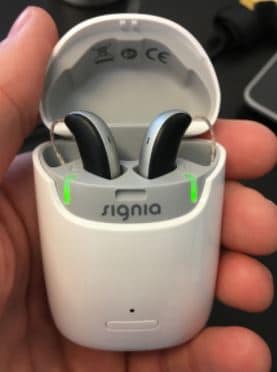 One of the most distinctive features of the Styletto X is the unique SLIM-RIC form factor and charging case that looks like it belongs to a set of Apple AirPods.
One of the most distinctive features of the Styletto X is the unique SLIM-RIC form factor and charging case that looks like it belongs to a set of Apple AirPods.
Taking the devices in/out of the case is a simple exercise and despite looking a bit longer than a traditional Receiver-In-Canal style hearing aid, it actually seems to contour the ear quite nicely.
Most rechargeable RIC devices today are often just slightly wider/thicker than their zinc-air battery powered counterparts. However, this is not true with the Styletto’s design, with its slender case being particularly unique due to its custom engineered lithium-ion battery.
Portable, Wireless Charging
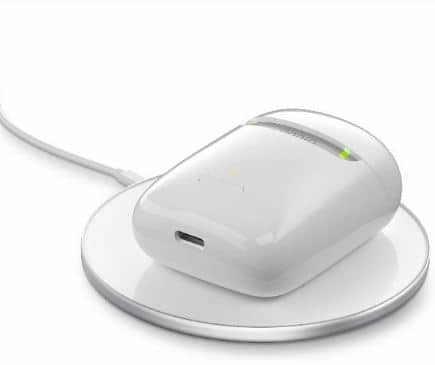
The new Styletto X charging case incorporates Qi wireless charging technology for added convenience.
The charging case, which is the first in the industry to offer wireless charging functionality, is a nice portable size that could fit easily in a pocket or purse without issue.
While the hearing aids don’t come standard with a Qi certified charger, but rather a USB-C charging cable, the wireless charging pads are widely available online for less than $20.
Charging the devices takes about 4 hours. According to the company, daily runtime without streaming is approximately 19 hours, and up to 16 hours with 5 hours of direct streaming.
Remote Session
After quickly pairing the hearing aids to the phone, the Signia app was downloaded in order to being our live video remote session with the audiologist.
The ease of beginning the remote session was notable, and would likely be an simple task for a majority of people without additional assistance.
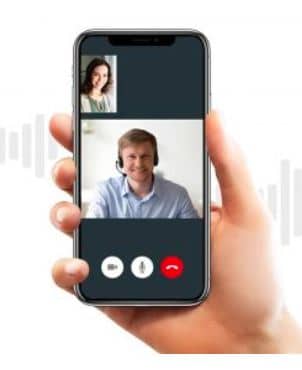
Signia TeleCare
During our session, the audiologist demonstrated various features and functionalities of the hearing aids. Sound quality was adjusted in real-time seamlessly throughout the session, much in the same way it would traditionally happen in the office during an in-person clinic visit.
In fact, for the hearing professional actually conducting a remote session, the process of adjusting the hearing aids is almost no different then how they would be typically be navigating the programming software during an in-person appointment.
Signia App and Assistant
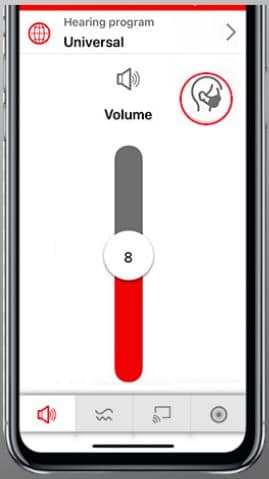
Facemask Mode can be activated by a quick tap of the icon on the app’s main screen
One of the most unique features of the Signia app, is the recently launched Facemask Mode We tested out the new Facemask Mode, both in the remote session and with multiple speakers wearing different types of face coverings, and found it to be highly effective at enhancing speech audibility.
In Facemask Mode, an audible sharpness is immediately apparent to the user as the speech frequencies receive increased amplification–as well as a change in directional focus towards the front microphones.
Beyond adjusting hearing aid volume, tone and directionality, which is accessible in the app, another particularly interesting and very useful feature is the Signia Assistant.
The Signia Assistant is incredibly intuitive and simple to use. You have the option of selecting four different categories for troubleshooting: My own voice, Other voices, Sound quality and Handling.

The Signia Assistant allows the end user to troubleshoot hearing aid issues
The Assistant will analyze the acoustic environment and then apply suggested changes based upon the wearer’s request. They can then choose to apply or discard the changes.
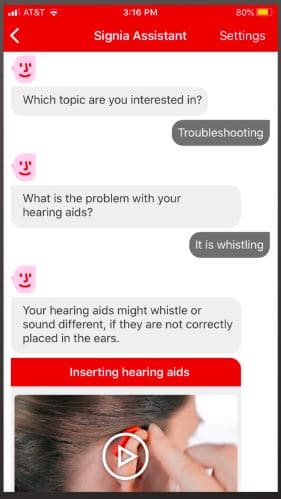 When selecting the ‘Handling’ category, this has the potential to save clinic time and the need for additional appointments, by offering guidance and even instructional videos to troubleshoot issues to the user–such as how to change a wax filter, for example.
When selecting the ‘Handling’ category, this has the potential to save clinic time and the need for additional appointments, by offering guidance and even instructional videos to troubleshoot issues to the user–such as how to change a wax filter, for example.
For hearing professionals curious or concerned about what sort of changes patients might be making with this tool, the datalogging feature–accessible when reading out the hearing aids–will show what changes are being made by the patient, which can be useful during follow-up counseling.
[For users looking for remote control functionality and remote microphone capability, Signia offers the Streamline Mic]
Verdict
There’s a lot to like about Signia’s Styletto X hearing aids. In addition to the non-traditional SLIM-RIC design of the devices, a unique feature set–including wireless rechargeability, motion sensors, Bluetooth connectivity and an on-board assistant–make them an attractive option.
The Styletto X is currently available in six technology levels: 1x, 2x, 3x, 5x and 7x.
For more details visit Signia’s website to learn more.
Interested readers can also watch the extensive video review below, courtesy of Mark Truong:







I have Signia, rechargeable aids, generally I like them. The batteries are ok, not great, charge time is quick. This is my 3rd pair (all different) brands – like these the best. From my experience don’t expect perfect hearing they all lack in voice clarity & sound quality re: conversation, TV, etc. Also today people don’t seem to enunciate well w/conversation, TV, radio, etc.
Thankyou for the clarification. No matter what hearing aids I use, I still miss more conversation than I feel I should. It is past frustrating.
By definition, those of us interested in watching this review have hearing issues, and I found I couldn’t hear some of the commentary clearly or at all. Captions would be very helpful.
Hi Amie, thanks for your comments!
There must have been a temporary issue, as the captions are working and displaying on the video now.
My hearing is most reduced in one ear. Could I use just one Styletto X device by itself?
I don’t like these ones the ear hearing aids! Especially during pandemic with wearing eyeglasses, a mask, and hearing aids that pull loose when removing your mask! Has many close calls on losing the hearing aid…and if it drops to the ground – you can’t hear it! And why don’t these manufacturers of hearing aids get the fact that people don’t have gray skin, nor white skin, nor silvery skin….like their hearings? Don’t the know there’s such a thing as “flesh color” that makes them almost invisible? Light flesh for caucasians, dark brown for African Americans, and another for Asians…DONE! I’ve had the sets of hearing aids so far in three different colors. None were flesh colored and if your hair is short, you can see them behind your ear!